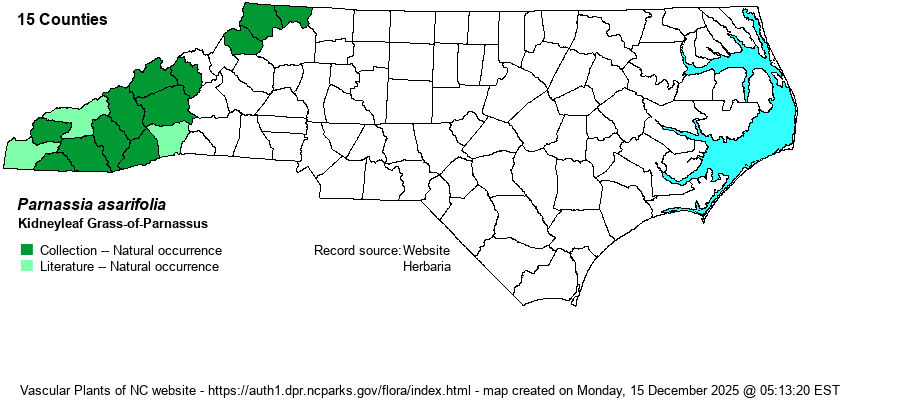| Author | Ventenat | |
| Distribution | Nearly throughout the Mountains, with collections for all but five such counties. Does not occur downstate.
This is primarily a central and southern Appalachian endemic species, ranging from southern MD and WV south to eastern AL; a disjunct population occurs in AR and eastern TX. | |
| Abundance | Uncommon to infrequent; locally rare in some areas. | |
| Habitat | This is a species of damp to wet ground, typically in seepages, bogs, margins of streams, and other damp ground, often at waterfalls. It favors acidic to near circumneutral soil, whereas the similar P. grandifolia occurs in somewhat high pH soils. |
| Phenology | Blooms from August to October, and fruits shortly after flowering. | |
| Identification | The three species of Parnassia are somewhat similar, and all have a cluster of basal leaves that are thick and shiny dark green. In this species, the leaf blade is reniform, about 2 inches long but about 2.5 inches wide, with a very rounded apex. From the base of the rosette grow several tall and naked flowering stalks, each topped by a single large flower. This stalk often grows about 1 foot high. The somewhat large flower has 5 ovate petals, white with parallel green veins; in this species the base is stalked ("clawed"). The spread of the flower is about 1.5 inches across. The other montane species - P. grandifolia -- has ovate to orbicular leaves, somewhat longer than wide, and the petals have no basal stalk. | |
| Taxonomic Comments | None
| |
| Other Common Name(s) | Appalachian Grass-of-Parnassus | |
| State Rank | S3 | |
| Global Rank | G4 | |
| State Status | | |
| US Status | | |
| USACE-agcp | OBL link |
| USACE-emp | OBL link |

